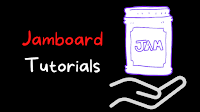
30 Aug Five Ideas for Using Google Jamboard This Fall
A couple of weeks ago I published an excerpt from The Practical Ed Tech Handbook. That excerpt mentioned a couple of ways to use Google Jamboard in online and in-person classroom settings. This morning I had a reader reach out to me to ask if I had any other suggestions that she could pass along to the teachers in her middle school. Between my blog and my YouTube channel I was able to come up with five ideas for using Jamboard in your classroom this fall.
A couple of weeks ago I published an excerpt from The Practical Ed Tech Handbook. That excerpt mentioned a couple of ways to use Google Jamboard in online and in-person classroom settings. This morning I had a reader reach out to me to ask if I had any other suggestions that she could pass along to the teachers in her middle school. Between my blog and my YouTube channel I was able to come up with five ideas for using Jamboard in your classroom this fall. Group Brainstorming SessionsJamboard can be used to host group brainstorming sessions. In larger classes I break students into smaller groups and have each group work on a specific page within the Jamboard session. At the end of the session we review the ideas from each page and put the most popular ones on a final page. Here’s an overview of how to use Jamboard in Google Classroom. Map Labeling ActivitiesI like to use Jamboard to create templates for activities for students to complete. Last summer I made a mapping template to show a colleague how Jamboard can be used in a geography lesson. The process for using Jamboard to create mapping activities can be seen in this video.Magnetic PoetryThis is an activity in which you create a template that has a bunch of words within little boxes made to resemble refrigerator magnets. You then distribute the template to your students for them to arrange the magnets to create poems. The process for making magnetic poetry activities can be seen here.Philosphical ChairsThis is a use for Jamboard that was inspired by a question a reader named Chuck sent to me last fall. The idea is to have students move their avatars around the Jamboard to indicate their positions on a given discussion topic. Here’s a video explanation of how the activity works.Create Instructional VideosCombine the use of a screencasting tool like Screencastify with a series of Jamboard pages and you can create an instructional video. The benefit of using Jamboard as your drawing tool instead of just using the built-in drawing tools in a screencasting tool is that you can distribute your Jamboard drawings and pages separately from the video if you want to. Here’s how to use Screencastify and Jamboard together to make an instructional video.  educational technology, Free Technology For Teachers, Google Jamboard, Google Workspace, how to, Jamboard, Teaching With TechnologyRead More
educational technology, Free Technology For Teachers, Google Jamboard, Google Workspace, how to, Jamboard, Teaching With TechnologyRead More


Sorry, the comment form is closed at this time.